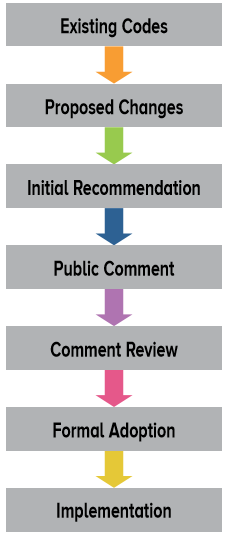Make the Building Codes Work for You
Make the Building Codes Work for You
This observation was made in an article published in the March 2006 issue of SBC Magazine, but that statement is just as true today as it was back then.

This flowchart shows the various steps building code changes typically go through from initial conception to final adoption.
Building codes have the potential to dictate the daily operations of a component manufacturer, impacting everything from how trusses are designed and manufactured, to whether there is a demand for them at all. Codes not only impact designs, but can also influence how cost efficient your customers consider your products. For example, recent large-scale fires in wood-framed buildings under construction have prompted some states to consider changing the building code to ban wood-framed construction. Without proactive involvement in the code development process (and sometimes legislative process, too), CMs can find themselves in a much less hospitable business environment.
This is why it is so important for individual CMs to be involved in local and statewide building code development and have a positive impact on the final language. Because of their critical role on the industry, SBCA is asking CMs to help the association build relationships with local building code officials, get involved in the development of codes to create the best regulatory environment for component manufacturing, and help track these ongoing changes at the local level.
Pat Coulter, the national director of component design for Builders FirstSource, says that by knowing in advance what changes to the local building code are being considered allows his company and others in their markets to advocate for common sense approaches.
“By attending code meetings and getting to know the code committee we can hopefully be seen as the industry experts and assist with the understanding of new proposals,” Pat says. “It is also important to know well in advance of the adoption of new codes to prepare our design teams for a smooth transition and be ready to educate customers about any code changes that could affect their costs. The more advanced notice they have, the better it will be for their business.”
SBCA is seeking to help the entire industry in this process. Staff is assembling a network of CMs and suppliers across the country to proactively monitor and engage in building code development on the local level. Do you have a relationship with your local building official or code development committee? If so, email us at codes@sbcindustry.com.
The more CMs are willing to get involved and share information with SBCA, the more effective everyone can be in protecting the best interests of the component manufacturing industry.

